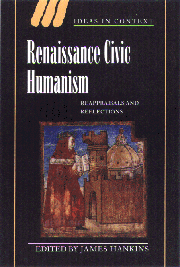Book contents
- Frontmatter
- Contents
- List of contributors
- Introduction
- 1 The republican idea
- 2 “Civic humanism” and medieval political thought
- 3 Civic humanism and Florentine politics
- 4 The two myths of civic humanism
- 5 Rhetoric, history, and ideology: the civic panegyrics of Leonardo Bruni
- 6 De-masking Renaissance republicanism
- 7 Civic humanism, realist constitutionalism, and Francesco Guicciardini's Discorso di Logrogno
- 8 Bruni and Machiavelli on civic humanism
- 9 Rhetoric, reason, and republic: republicanisms – ancient, medieval, and modern
- 10 Situating Machiavelli
- Index of manuscripts and archival documents
- General index
- Ideas in context
6 - De-masking Renaissance republicanism
Published online by Cambridge University Press: 06 October 2009
- Frontmatter
- Contents
- List of contributors
- Introduction
- 1 The republican idea
- 2 “Civic humanism” and medieval political thought
- 3 Civic humanism and Florentine politics
- 4 The two myths of civic humanism
- 5 Rhetoric, history, and ideology: the civic panegyrics of Leonardo Bruni
- 6 De-masking Renaissance republicanism
- 7 Civic humanism, realist constitutionalism, and Francesco Guicciardini's Discorso di Logrogno
- 8 Bruni and Machiavelli on civic humanism
- 9 Rhetoric, reason, and republic: republicanisms – ancient, medieval, and modern
- 10 Situating Machiavelli
- Index of manuscripts and archival documents
- General index
- Ideas in context
Summary
“The city of Florence was always much more enthusiastic for liberty than other cities – in fact, as you know, the name of Liberty can be seen written in gold letters among her public emblems”; “liberty is no less engraved in men's hearts than it is written on our walls and banners.” The survival of the blue shield crossed with the word “liberty” on the Palazzo Vecchio in Florence seems to confirm the proud boast of the Florentines Alamanno Rinuccini and Francesco Guicciardini. But in fact by the time they were writing in the late fifteenth and early sixteenth century, the republican ideal was already losing credibility. Belief in the values described by Quentin Skinner – which are depicted so graphically on the walls of the Sala del Buon Governo in Siena – was being replaced by skepticism about the claims made for liberty. Yet because liberty was (and remains) an empowering word in republican political vocabulary, it is not so easy to put one's finger on the moment when the slow process of disbelief begins, engendered by a perceived gap between political reality and the rhetoric of liberty. In fact, it is the very men I begin by citing, Rinuccini and Guicciardini, who go on to undermine it by warning us that “these exotic signs and words clash with the facts,” for liberty is no more than a “name” whose “appearances and image” are used as a pretext to deceive people and to “dazzle” them.
- Type
- Chapter
- Information
- Renaissance Civic HumanismReappraisals and Reflections, pp. 179 - 199Publisher: Cambridge University PressPrint publication year: 2000
- 12
- Cited by



